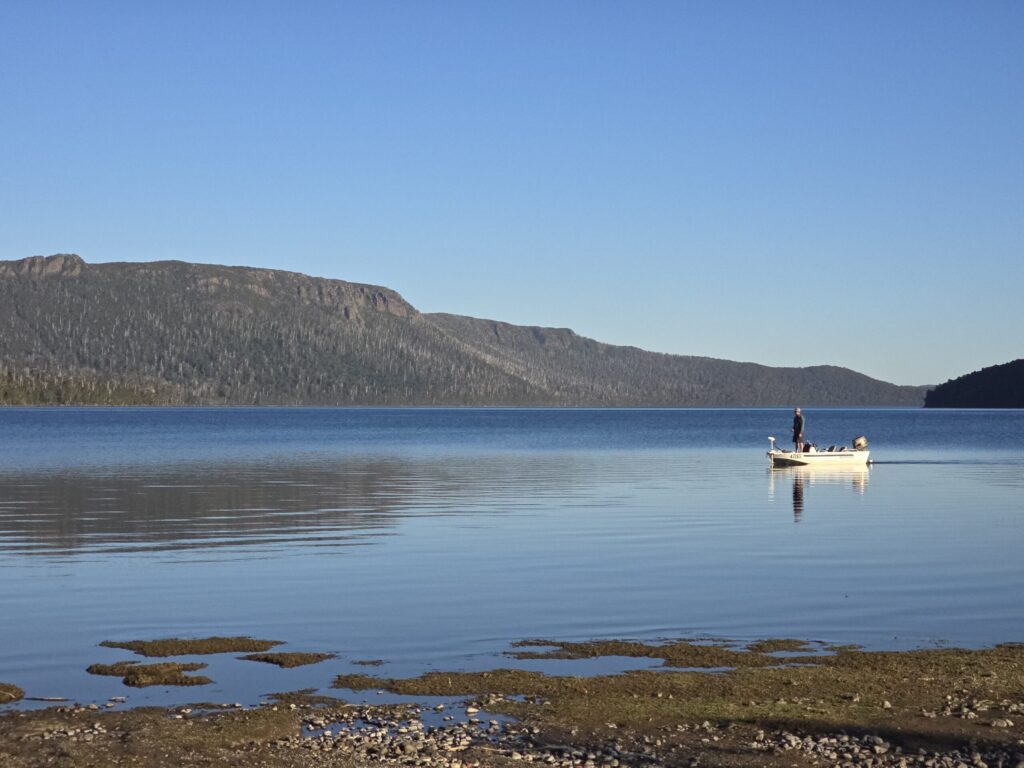Tough spring, great summer:
We hit the ground running upon my return from the USA a few months ago, only to hit the roadblock of prolonged cold springtime weather. The combination of this cold weather and the preceeding autumn/winter drought (which broke in spring), meant that the river fish had effectively only just finished spawning at the end of September. Fortunately the fish began getting back to usual habits by late-October, but this makes it the latest start to spring river fishing that I’ve ever experienced in Tasmania.
The usual hatches were in full swing by the 3rd week of November, including caddis and mayfly. Mixed weather continued into December, with afternoon thunderstorms bringing on some of the thickest baetid hatches I’ve ever fished, and the first consistent dry fly fishing days of the season. Curiously the fish have been shy on the snowflake caddis this season, and seemingly fixated on size 20 baetid mayfly on many rivers, or size 16 black spinner (Nousia sp.) instead.
December and January also brought out masses of beetles and grubs in some of the most consistent numbers in years, with soldier beetles, lady beetle larvae, gumleaf skeletoniser catepillars, and eucalypt gum beetles all making regular appearances on warm days. Just last week myself and a friend camped at the far end of a wilderness lake containing a 3km slick (lake current) turned yellow by the sheer numbers of gum beetles on the water. As you’d expect the fish were full to the brim, but a massive spinner fall on evening brought about an hour and a half of very fun Tasmanian dry fly fishing interspersed with a few tailers.
If you’ve read my last cormorant blog post, you’ll know that the cormorant plague is over and the fisheries are bouncing back. It’s still easy to hit the wrong water and fail to find fish to cast at, but that is where our local knowledge and more than twenty years of guiding experience comes into play. Apart from hitting the right types of waters, the key is targeting the right habitats, and using more more stealth than normal. Stay in the shadows, and avoid wading up the centre of the river. Entering the river across from rising fish, rather than wading up-river, and setting up cross-stream presentations with longer leaders (eg 15foot) has also been a regular and important tactic for bigger fish sipping duns. You can read more about the benefit of cross-stream presentations on our blog post here. Two northern streams already have the best conditioned fish that we’ve seen for five or so seasons where 16 inch fish are weighing between 1.5 and 2lbs. The lower fish numbers will ensure that these larger than average river fish will continue to thrive, and be a feature for atleast the next 12 months (expect the chance of 3lb small stream fish next season).
Similar to the rivers, the Nineteen Lagoons and Western Lakes have also had some great sight fishing opportunities. But once again post-cormorants, it is a case of knowing what habitat and lake structures to target to make sure you aren’t in the wrong place at the wrong time. Since Christmas we’ve been hitting really solid black spinner mayfly falls and dun hatches on a couple of the 19 Lagoons (we are keeping these locales to ourselves for now), and on multi-night campouts further west. The fish numbers have been really good across the Christys Creek and Pine River systems, and the average fish size has been as big as they ever get: guests have landed one five pound brown, and snapped off two others of the same size in the past fortnight during dun hatches on overcast days, in lakes that we usually expect 1.5-3lb fish.
Rather than Scruffies and Damsels, our best flies so far this season have been small black spinners and unweighted nymphs, sightfished to rising or sub-surface feeding trout. This is likely a symptom of the post-coromorant spookiness we are seeing among the fish, who are very sensitive to out-of-context heavy presentations (smacking down a damsel on a damsel feeder still works bloody well!).
The river and lakes levels are ideal going into late summer. Fingers crossed for a dry spell that browns the grasses off, and brings the hoppers on which are starting to show in paddocks. More consistent hydro flows at Brumbys Creek would also be good, but the smaller streams and Western Lakes are looking prime for the next eight weeks of what is typically Tasmania’s best weather and fishing. If you are keen for a few days of Tasmanian fly fishing this season, send me a quick email here and let us use our 24 seasons of guiding experienceto ensure that we hit the best fishing on the day.

